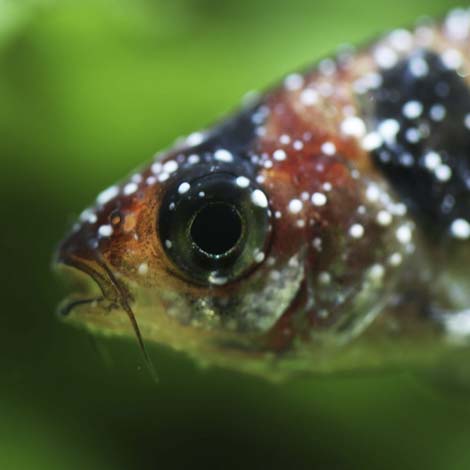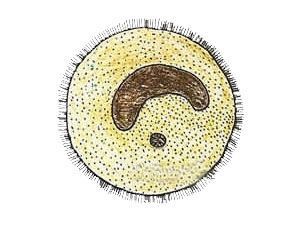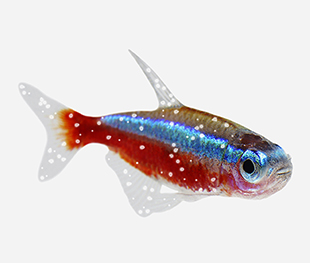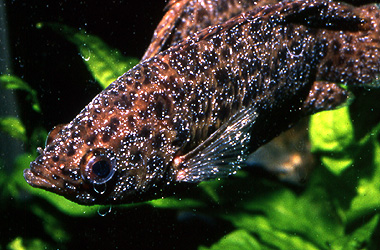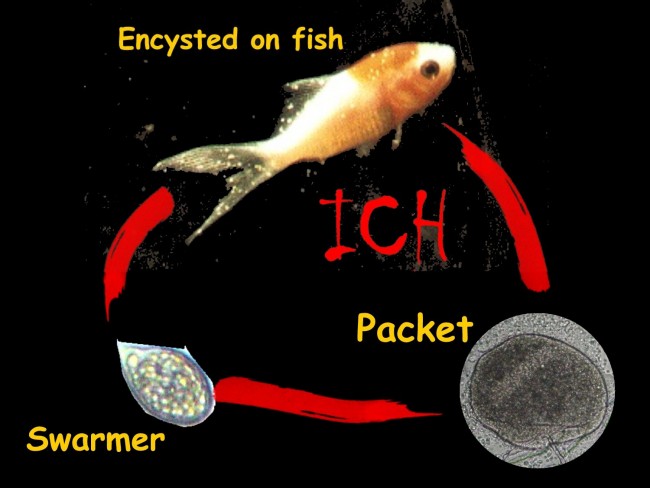White Spot -Ich
Caused by: Ichthyophthirius multifiliis
Ich (also called white spot disease) is one of the most common and most damaging protozoan diseases of freshwater fish. It affects both wild and cultured species including ornamental fish, carp, tilapia, catfish, and many others.
Introduction
Ich (also called white spot disease) is one of the most common and most damaging protozoan diseases of freshwater fish. It affects both wild and cultured species including ornamental fish, carp, tilapia, catfish, and many others.
The disease is highly contagious and characterized by white cyst-like spots on the fish?s body, fins, and gills.
It causes rapid mortalities, especially in stressed or newly introduced fish.
Identification
A protozoan ciliate parasite-
Large (0.5?1.0 mm), visible under low magnification .Oval or spherical shape with unique: C-shaped macronucleus. Dense cilia covering its body surface.
Life Stages - Ich has three major life-cycle stages:Trophont (on fish), Visible white spots,Feeds on skin and gill tissues, Protected from treatment, Tomont (on substrate) Falls off the fish, Encysts on tank bottom or surfaces, Divides into hundreds of theronts, Theront (free-swimming infective stage), Infects new fish, This stage is vulnerable to treatment.
Identification / Clinical Signs - Physical Signs - White salt-like spots (0.5?1 mm) on: Skin, Fins , Gill plates, Frayed fins, Cloudiness on skin, Excess mucus production.
Behavioral Signs - Flashing / rubbing against objects, Gasping at surface (if gills are infected), Lethargy, loss of appetite, Rapid breathing , Advanced Cases - Severe gill damage, Secondary bacterial and fungal infections, Sudden mass mortality.
Pathogen Characteristics
Prevention & Treatment
Prevention Measures
Best method: Keep Ich OUT of the system.
Key preventive strategies include: Biosecurity, Quarantine new fish for 14?21 days, Disinfect nets, buckets, tanks
Avoid mixing fish from different suppliers - Water Quality Control, Maintain stable , temperature, Avoid ammonia/nitrite spikes, Reduce stress during handling, Farm-Level Measures, Drying and liming ponds between cycles, Filtration and UV sterilization in RAS/ornamental systems, Monitor fish daily for abnormal behavior
Treatment Options
Only the free-swimming theront stage is killable, not the white cysts.
1. Increase Temperature (if species allows)
Raise to 28?30?C to speed up the parasite life cycle.Fish like goldfish, carp, tilapia tolerate this.
2. Salt (NaCl) Treatment
Effective for many freshwater species.
0.3% (3 g/L) to 0.5% (5 g/L) for baths, 0.1?0.3% for long-term treatment (species-dependent)
3. Formalin + Malachite Green (most effective farm treatment)
Used widely in commercial aquaculture, Effective against theronts, Must follow proper dosage and safety guidelines
4. Potassium Permanganate (KMnO?)
Used for ponds and tanks, Effective for external parasites,
5. Copper Sulfate (pond systems only)
Requires precise alkalinity measurement,
Typical dose: 0.2?0.3 mg/L (1 ppm per 100 ppm alkalinity)
6. Other Supportive Measures
Improve aeration, Remove organic waste, Vacuum tank bottom daily (removes tomonts)
Photo Gallery
